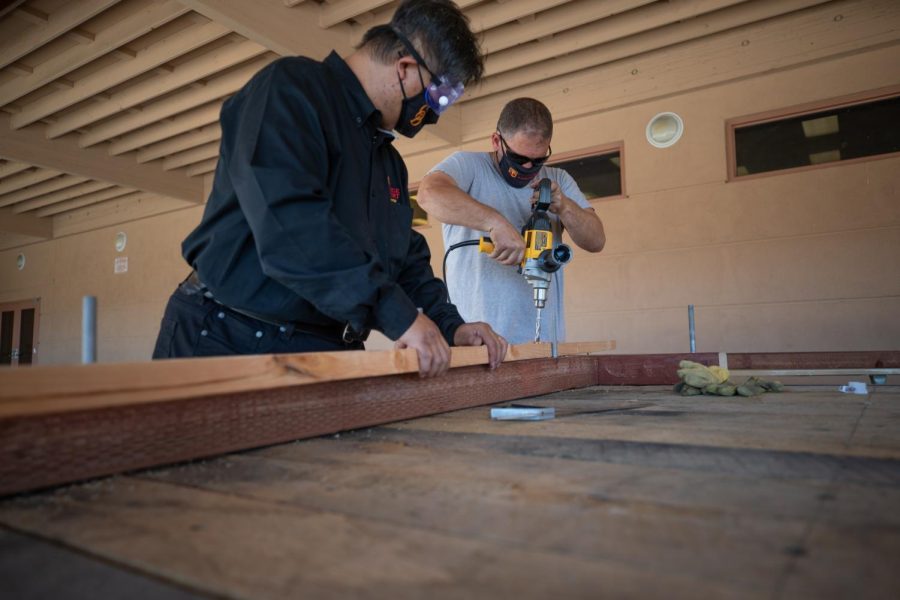Students team with carpenters council to build tiny home
Tiny homes have a big impact in our communities
Photo courtesy of COD. Professor Bert Bitanga assists students in the early stages of November 2021 of the tiny house build.
College of the Desert students and the Desert Sands Unified School District have joined forces with the Southwest Regional Council of Carpenters to build a ‘tiny home,’ aiding the community while earning school credit and learning construction skills at the same time.
Eighteen students began working on the tiny home in October of 2021 under the guidance of professional carpenters, and it is expected to be ready for occupancy by April of this year. The home measures about 20-by-8 feet and will have full electrical capabilities. The small space features a cooktop, sink, toilet and shower. A sleeping nook is tucked away above the kitchen and bathroom.
The tiny house build doesn’t just benefit the students; it also presents an opportunity for local residents seeking affordable housing options.
— Bert Bitanga
“The students learned valuable skills such as building, wiring, electricity, plumbing and so much more,” said Bert Bitanga, the professor of architecture at College of the Desert who oversees the project. “The tiny house build doesn’t just benefit the students; it also presents an opportunity for local residents seeking affordable housing options.”
In recent years, the tiny home concept has increased as an alternative to traditional housing, primarily because of its lower cost and mobility. Smaller homes are less expensive than larger ones regarding taxes and building, heating, maintenance and repair costs. New construction costs have skyrocketed for traditional houses, and most tiny homes can be moved from one place to another using the trailers on which they are built. “The goal of a tiny home is to maximize space without compromising on the comforts of home,” Bitanga said. “Because of its small size, it is a very affordable option for housing.”
Tiny homes are generally designated as being under 600 square feet, but the average size of a tiny house in the U.S. is about 225 square feet, or roughly eight times smaller than a typical home. Across the globe, tiny homes are being utilized as an alternative for the growing homeless problem. Shelter pods and tiny home villages have become part of the solution for many U.S cities and around the world. The trend toward tiny houses has also become a social movement. More people are choosing to downsize the space they live in, to simplify their lives and consume less. The most popular reasons for downsizing include environmental concerns, financial concerns, and the desire for more time and freedom.
College of the Desert offers numerous construction courses which include all aspects of carpentry from framing and finish carpentry to plumbing and electrical. These courses offer degrees and certificates in architectural technology and construction management. Additionally, as part of its Career Education program, the College works with industry and employers to develop courses needed to prepare a qualified workforce for in-demand jobs. A rigorous academic curriculum is integrated with workforce skills in more than 30 career pathways. Additional information is available on the college website.
The Southwest Regional Council of Carpenters represents more than 57,000 members in Southern California, Nevada, Arizona, Utah, New Mexico and Colorado. They work with developers and elected leaders to raise the standard of building and living for all workers.
The council is currently constructing the Tiny Home Village, New Mexico’s first tiny home transitional housing project. This project will create a shared living environment in which residents who have been experiencing homelessness enter the village to begin living again in a home of their own within a safe and secure community.
















